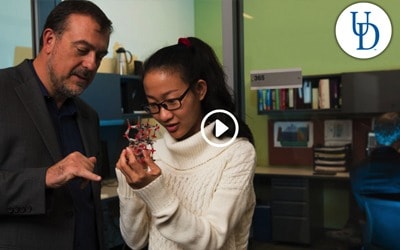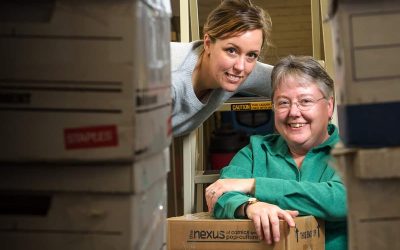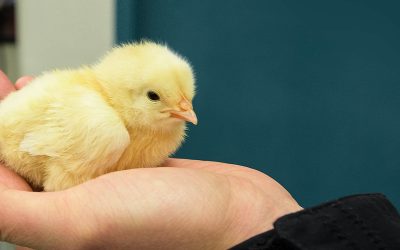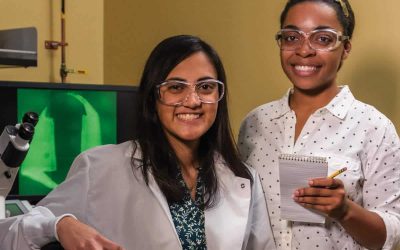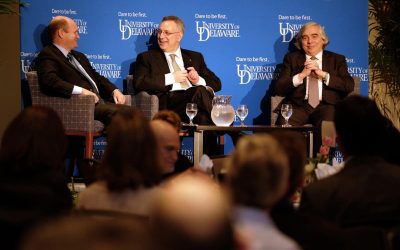
Researchers at the University of Delaware recently received a grant from the National Institutes of Health to explore the use of the 22-inch robot in a new approach to pediatric rehabilitation based on social interaction between robots and humans.
The team—robotics expert Herbert Tanner, mobility researcher Cole Galloway and computational linguist Jeffrey Heinz—will collaborate with researchers at the Johns Hopkins University Center for Imaging Science on the project, known as GEAR (Grounded Early Adaptive Rehabilitation).
“Our hope is that the robot will act as a magnet for very young children with disabilities, along with their typically developing peers, engaging them in dynamic group activities—controlled chaos full of fun, friends and fitness,” says Galloway, founder of the global GoBabyGo program and a professor in the Department of Physical Therapy.
“Pediatric rehabilitation equipment and training currently do not meet the needs of kids with motor disabilities,” he adds. “Young children’s overall knowledge depends on their ability to be mobile with peers—once they start moving, they begin to learn about the world in fundamentally different ways.”

The robot Nao will be programmed to react to the behavior of an individual child with motor disabilities and deliver personalized training to advance the child’s mobility.
Much more than a toy
It’s no accident that NAO resembles a toy more than a research tool, but he’s a very sophisticated “toy.”
“NAO will interact socially with children and engage with them,” says Tanner, who is an associate professor in the Department of Mechanical Engineering. “But, even more importantly, the robot will be programmed to react to the behaviors of individual children and deliver personalized interventions.”
Heinz, an associate professor in the Department of Linguistics and Cognitive Science whose expertise lies in machine learning, will work with Tanner on new algorithms that will enable the robot to devise plans on its own based on its environment.
This capability is what will enable NAO not only to lead kids through a prescribed sequence of steps in a choreographed training routine, but also to know when enough is enough.
If a child’s attention wanders, NAO will redirect her attention to an activity likely to reengage her. If a child shows signs of fatigue, NAO will offer him a more restful activity.
“We all know that babies’ behavior is highly dynamic,” says Galloway. “NAO and our entire research team will have to be equally dynamic, which should result in both significant and innovative gains for pediatrics and robotics.”
Scaling up for positive impact
NAO will be used in conjunction with a portable harness system that partially supports the weight of special-needs kids and allows them to move freely in an 80-square-foot space, as well as with a network of cameras, sensors and accelerometers that record the subjects’ motion.
Experts at Johns Hopkins will develop activity recognition algorithms so that NAO can discern fine distinctions in the types of movements the children make.

Tanner, who has already worked with Heinz in applying lessons from child learning to robot training, is happy to be involved in a project focused on kids with special needs.
“This work has the potential to have a clear and immediate effect on people’s lives,” he says.
The project is funded through NIH’s Eunice Kennedy Shriver National Institute of Child Health and Human Development.


The trouble is, she writes in a recent issue of Academic Medicine, the journal of the Association of American Medical Colleges, too many of these so-called short-term experiences in global health, or STEGH, focus on the needs of the student trainees and not on what’s best for their patients or for overall health care in the countries they visit.
“Most students who participate in these programs genuinely want to help people,” Melby said. “But many may not be aware of the unintended consequences that can occur.”
Melby, who specializes in the biological and medical aspects of anthropology, is the lead author of the article, written with colleagues who are medical doctors involved with global health care issues. Her co-authors, who connected with her through the Delaware Health Sciences Alliance, of which UD is a founding partner, sought her out for an anthropological perspective.
While STEGHs can provide students with important global and cross-cultural education, the authors say they believe a paradigm shift is needed to ensure that the programs benefit both the trainees and the communities they visit. And, Melby said, the proposed guidelines can apply beyond medical or pre-med students to include other study-abroad and global service-learning programs.
“We think these principles are relevant to a lot of student groups that do global work,” she said. “Most people’s hearts are in the right place, but there are often aspects to what they’re doing that they just don’t think about.”



But a multi-year regional study at the University of Delaware suggests that home shopping has a greater impact on the transportation sector than people might think. The results are documented in “Impacts of Home Shopping on Vehicle Operations and Greenhouse Gas Emissions,” published in the International Journal of Sustainable Development and World Ecology.
The study, which focused on the city of Newark, Delaware, was led by Arde Faghri, professor in the Department of Civil and Environmental Engineering and director of the Delaware Center for Transportation (DCT).
The project included data collection through a survey to identify shopping behavior and a summary of the survey results by product category, followed by simulation and analysis.
“Our simulation results showed that home shopping puts an additional burden on the local transportation network, as identified through four measures of effectiveness—travel time, delay, average speed and greenhouse gas emissions,” says co-author Mingxin Li, a researcher at DCT.
While it’s true that e-stores require less space and use less energy, Faghri points out that online shopping puts more delivery trucks on the roads, which translates into more wear-and-tear on pavements and increased environmental pollution through the emission of fine particulate matter from diesel engines.
An additional problem is that residential and downtown streets were not designed to accommodate frequent truck stops, parking, loading and unloading, so trucks can interfere with through traffic, causing delays and compromising safety.
But what may be the most surprising finding of the study has nothing to do with increased truck traffic.
“We found that the total number of vehicle miles traveled hasn’t decreased at all with the growth of online shopping,” Faghri says. “This suggests that people are using the time they save by shopping on the Internet to do other things like eating out at restaurants, going to the movies or visiting friends.”
Faghri cautions that his study looked only at residential commerce, not purchases made by commercial and industrial businesses, and that the data his team collected was limited to a very small geographic area.
However, he emphasizes that local, state, regional and national planners need to keep a close eye on the impacts of the home shopping trend when planning and budgeting for infrastructure needs.
“The increase in online shopping also affects land use patterns such as the number and size of stores in large shopping malls with vast parking spaces, as well as changes in labor markets, with, for example, less demand for sales personnel and more for truck drivers,”
he says.

Hundreds of University of Delaware students, though, are using the time to press on with research projects, build foundational understanding in their fields of interest and tap into the savvy of faculty mentors.
On UD’s Tumblr page, we offer a baseball-card-type glimpse into UD’s labs and work spaces, featuring a full roster of students and mentors. Here are just a few of our heavy-hitters:
- Eva Allison of Storrs, Connecticut, studying the baskets of the Nanticoke Tribe.
- EJ Carron of Green Brook, New Jersey, looking for ways to harness the clean energy produced by “aeroelastic galloping.”
- Nadisha Downs of Wilmington, Delaware, studying young African-American men’s perceptions of fatherhood.
- Cedric Whitney of Washington, D.C., working on ways to provide prosthetic hands using 3-D printing in La Paz, Bolivia.


MORE STORIES
Energy IQ
Put your Energy IQ to the test, and let’s see if you are an energy guru or a fossil fool.
Catalysis Center for Energy Innovation
Cool video highlights CCEI’s mission of turning cornstalks and wood chips into fuels, electricity and chemicals.
Scanlon papers now part of disaster resource collection
T. Joseph Scanlon, a respected journalism professor in Canada, had a long-time relationship with the University of Delaware’s Disaster Research Center, which is now the repository of his over 70,000-piece collection.
Honors
The UD community celebrates its first Gates Cambridge Scholar, two new fellows in the National Academy of Inventors, and the first woman to receive the Soil Science Society of America’s Kirkham Soil Physics Award.
Keeping a killer flu in check
Who do you call when bird flu comes knocking? UD’s Avian Biosciences Center is working to contain the threat of bird flu—locally and globally.
Research Magazine Survey
We value your opinion. To show you how much, we will award a $100 Barnes & Noble gift card to three people who complete our survey. To be entered in this random drawing, please complete the survey by Nov. 1, 2016.
UD Authors
In her award-winning book, historian Christine Heyrman explores how the first U.S. missionaries in the Middle East influenced a nation’s attitudes toward Islam.
What science writing can teach us
Journalist, author and UD’s Distinguished Writer in Residence Mark Bowden shares lessons he learned as a science writer and recent samples of his students’ work.
New Train Station Project on Track for STAR Campus
An upgraded transportation hub in Newark will bring new riders and serve as an anchor for UD’s 272-acre Science, Technology and Advanced Research (STAR) Campus.
A trusted partner when the world turns upside down
Decisions made in times of disaster can be the difference between life and death, restoration and ruin. UD’s Disaster Research Center offers field-tested methods to strengthen recovery efforts.
Ch-Ch-Ch-Changes…
With significant change all around us, Delaware’s leaders—including the University of Delaware—are working to turn adversity into new opportunity.
Fueling the quest for green energy
Turning cornstalks and wood chips into renewable energy and valuable chemicals isn’t easy, but it is a promising focus of research at the Catalysis Center for Energy Innovation.




